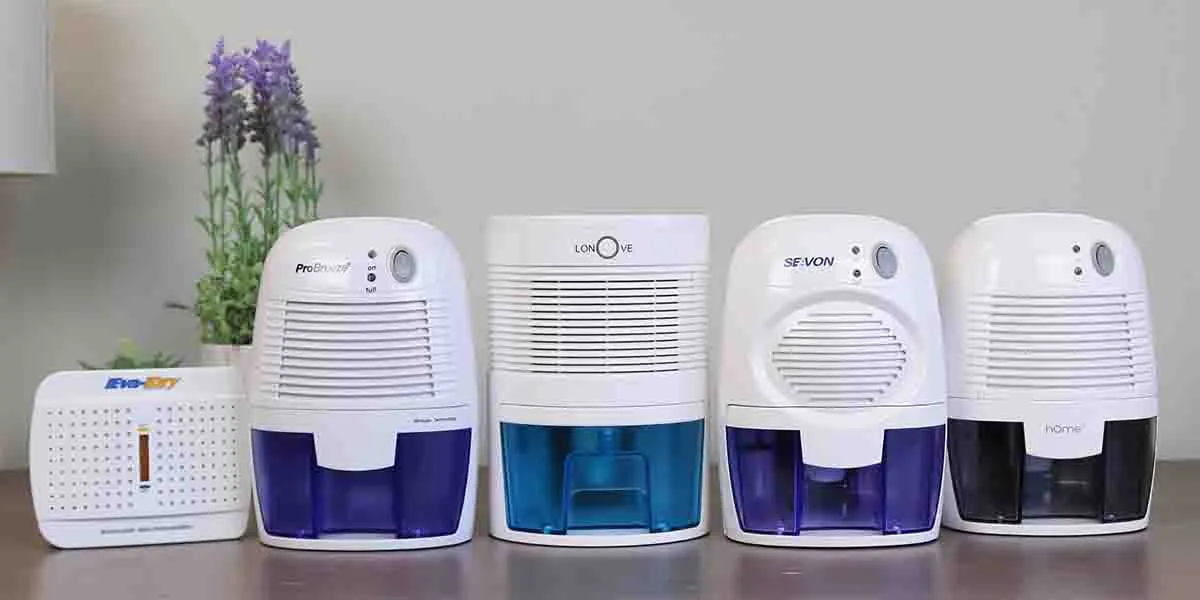Your bathroom is the most likely room in your house to have high humidity. The need for a bathroom dehumidifier for moisture removal is likely, depending on the amount of moisture in your bathroom. A bathroom with humidity levels above 60% are recommended to use a small dehumidifier to maintain desired humidity level. We cover the small dehumidifiers we’ve personally tested in the past couple years, and recommend our 5 best small dehumidifiers of 2023.
Living with continuously high levels of humidity in any room can be a hotspot for dust mites, mold, and mildew. According to Environment Protection Agency, relative humidity levels between 30% and 50% are safe levels for a room. However, this can be difficult to achieve in a bathroom, especially without removing excess moisture.
In your entire home, your bathroom is a place where you’ll find high levels of humidity. With every shower or bath, you increase the moisture in the air. A bathroom being one of the most humid spaces in your home requires a bit of planning.
What’s the solution?
Dehumidifier Basics
A dehumidifier can help significantly improve the air quality by removing moisture from the air, preventing the growth of mold and mildew. A bathroom that has poor ventilation and especially if it has no window to the outside, a dehumidifier will help remove the moisture from your home.
Smaller dehumidifiers are perfect for small spaces such as a smaller bathroom, bedroom or laundry room. The smaller air space calls for a compact and affordable dehumidifier, making it an easy decision as they are not going to break the bank. When shopping for the best dehumidifier for your bathroom, you should consider some of the important factors such as capacity, portability and noise level. Its always nice to have a portable, easy to setup unit you can move room to room.
Below is our round-up buying guide for picking the right small dehumidifier for your bathroom in 2023.
Small Bathroom Dehumidifier Buying Guide
Water Tank vs Absorbing Capacity
At the core of any dehumidifier is its water tank. This vessel is responsible for containing the moisture that the dehumidifier extracts from your bathroom’s atmosphere. Each dehumidifier has a specific water tank capacity, denoted by the number of pints of water it can store. For example, a dehumidifier with a 1 pint water tank can accommodate approximately half a liter of water.
However, the water tank capacity is only one piece of the puzzle. The dehumidifiers moisture absorption rate, or its ability to extract pints of moisture from the air in a day is just as important. This is sort of like the dehumidifiers horsepower – how swiftly it can work to decrease humidity levels in your bathroom.
A useful rule to remember is this; the larger the space you need to dehumidify, the higher the absorption rate should be. Consequently, a dehumidifier with a greater water tank capacity and a higher moisture absorption rate will typically come with a higher price tag.
Because bathrooms are typically among the smaller rooms in our homes, a compact dehumidifier with an absorption rate of 12 to 25 pints of moisture per day is best for bathrooms. This size can effectively maintain a balanced humidity level in your bathroom and surrounding space.
However, if you are dealing with larger space, go for high-capacity dehumidifiers. A high moisture absorbing capacity dehumidifier works best to handle an excessive amount of humidity in large spaces quickly.
Portability
You might not want your dehumidifier to be ideal in the bathroom only. Portable dehumidifiers come in handy when moving it to another part of the house.
Most cord-based dehumidifiers can be shifted from one place to another as it requires an outlet to be plugged in. Also, some models come with wheels and a handle to move around.
Another type of dehumidifier you might find is mini-dehumidifier. This cordless model is way smaller (size of a hand) and uses silica gel to trap water particles from the air. It is portable but not recommended as it won’t be effective in dehumidifying.
Noise Level
Dehumidifiers can be noisy sometimes. The main source of noise is its compressor, fan, and airflow (swirling sound). When picking a dehumidifier for your bathroom check whether it falls under recommended noise levels.
In general, a noise level between 53 dB and 57 dB is considered quiet (sounds like moderate rainfall). And below 53 dB is considered super quiet (sound of a refrigerator).
Here is a list of different noise levels of dehumidifiers to determine how noisy it can be:
- Loud dehumidifiers: Over 65 dB.
- Noisy dehumidifiers: Between 60 dB and 65 dB.
- Neutral dehumidifiers: Between 57 dB and 60 dB.
- Quiet dehumidifiers: Between 53 dB and 57 dB.
- Super quiet dehumidifiers: Below 53 dB.
Automatic Shut-Off and Defrost
Its not easy or convenient to monitor your dehumidifier to see when the water tank is full and in need of emptying. This is where the auto shut-off feature is a must-have. This enables the appliance to automatically power down when it detects the water tank is nearing capacity, preventing any overflow incidents. Very handy!
Another important feature that makes your life easier, particularly in colder climates, is the auto-defrost. This guarantees that your dehumidifier continues to function efficiently even in lower temperatures, such as during winter or rainy seasons, by preventing the formation of frost on the coils.
Drainage System
Mainly dehumidifiers employ one of two types of drainage systems: a removable tank or continuous drainage.
Removable tanks, often in the form of sliding trays, are commonplace in most dehumidifiers. When the water collected reaches capacity, you’ll need to empty the tank manually. This operation is usually straightforward and easy to execute, making it an easy-to-empty solution for your dehumidifier.
On the flip side, some dehumidifiers offer a continuous drain feature. This system involves connecting a drainage hose to the dehumidifier, leading the water straight into a sink or floor drain. This option lets your dehumidifier remove pints of moisture from the air per day without the need to empty a tank, offering a hands-off approach to managing humidity levels in your bathroom.
Built-in Humidistat Tool
A built-in humidistat tool is another feature that can elevate your dehumidifier’s performance. This tool measures the moisture levels in your bathroom and ensures the relative humidity (RH) is maintained within a comfortable range. By providing real-time humidity readings, the humidistat helps you understand and control your bathroom environment better, enabling your dehumidifier to keep your home in the optimal humidity range.
5 Best Small Dehumidifiers for Bathroom
SEAVON Electric Dehumidifier

Water Tank Capacity: 16 Oz (500ml) | Working Efficiency: 300 ml/day | Dehumidification Range: 205 square feet | Noise Level: 30 dB (Super Quiet) | Drainage Type: Sliding Tank
The SEAVON electric dehumidifier is one of the most affordable options on the list, the device comes in a compact size, which makes it easy to move from one room to another.
If your bathroom’s dehumidification range lies around 200 square feet, you can consider using this dehumidifier. The device is capable of extracting 300 ml of water in 24 hours and can hold 500 ml of water in its tank.
Moreover, the device automatically shuts down when the water tank is full and needs draining. There is a LED light that blinks RED when the water tank reaches its maximum capacity, indicating you to empty the tank.
In terms of noise, the SEAVON Electric Dehumidifier produces a low amount of sound (30 decibels). With built-in Thermoelectric cooling technology, this electric dehumidifier makes no noise (sound like a whisper).
As said earlier, due to its compact size, it is perfect for various home locations such as bathrooms, bedrooms, kitchens, and even your office. Overall, an affordable and eco-friendly dehumidifier that provides significant air quality.
Midea 2019 DOE

Water Tank Capacity: 100 Oz (3 liters) | Working Efficiency: 24 liters/day | Dehumidification Range: 4500 square feet | Noise Level: 51 dB (Super Quiet) | Drainage Type: Sliding Tank + Draining Hose
The Energy Star Certified Midea 2019 DOE model uses a more efficient compressor, coil, and fan inside to maintain appropriate humidity levels of 45%-55% in the room. The device can effectively cover an area of 4500 sq feet for dehumidifying the environment.
With portability in mind, the brand has included 4 wheels and a handle to move it freely around the rooms. Apart from the bathroom, you can place it in the bedroom, office, kitchen, or crawlspace where RH levels are high.
Talking about the water extraction capability, the Midea 2019 DOE is capable of extracting 24 liters of water from the air. The included tank is capable of holding 3 liters of water and automatically shuts off when the tank is about to overflow, thanks to the auto shut-off feature.
Many dehumidifiers get disrupted by power outages. To solve this issue, Midea has included an Auto-restart feature that restarts the device when power is back. Moreover, you can also enable continuous dehumidification mode to operate constantly, instead of switching on or off.
The Midea 2019 DOE is quiet with a noise level of 51 dB that sounds more like a whisper. It gets completely dissolved into the surrounding sound, so you’ll barely notice any noise. Overall, its energy star certification and advanced features make it worth investing in.
SEAVON Dehumidifier (4th Gen)

Water Tank Capacity: 61 Oz (1.8 liters) | Working Efficiency: 750 ml/day | Dehumidification Range: 510 square feet (small rooms) | Noise Level: 39 dB (Super Quiet) | Drainage Type: Sliding Tank
The SEAVON 4th gen dehumidifier covers a range of 510 sq feet which makes it suitable for small bathroom spaces. Its water tank can hold up to 1.8 liters of water whereas the dehumidifier can remove 750 ml of water moisture from the air in 24 hours.
Like previous models, the auto shut-off feature manages to turn the dehumidifier off automatically, saving water from spilling off. For you to notice, the LED light turns red when the water tank is full and needs to be emptied.
Unfortunately, the device lacks gravity-draining support. You have to slide the water tank to make it empty. At this price, adding a socket for a draining hose would have been worth it.
This model from SEAVON comes with a remote for contactless operation such as switching the device on/off or changing working modes. The working modes consist of two modes; strong and sleep. Strong mode sets the fan at maximum speed to reduce humidity quickly whereas night mode sets the fan to a suitable speed for better sleep at night.
One thing to note here is if the room temperature falls below 59 degrees Fahrenheit, the dehumidification won’t perform and the device stops working on temperatures below 49 degrees Fahrenheit.
It is rated ultra-quiet with a noise level rating of 39 dB. Therefore, In my opinion, if you are looking for a quiet dehumidifier for small spaces which improve the air quality, then the SEAVON 4th gen dehumidifier.
Ivation Dehumidifier

Water Tank Capacity: 67 Oz (2 liters) | Working Efficiency: 7 liters/day | Dehumidification Range: 270 square feet (small rooms) | Noise Level: 30 dB (Super Quiet) | Drainage Type: Sliding Tank + Draining Hose
For pretty small bathrooms, we highly recommend Ivation dehumidifier, covering a range of 270 sq feet. It can absorb up to 7 liters of moisture from the air within 24 hours. And hold up to 2 liters of water in its tank.
More importantly, the auto shut-off feature works fine when water is about to overflow. You can use either the sliding tank or hose as this gives you the freedom to empty the tank based on your preference.
Its compact design features a handle to move from one room to another, which makes it highly portable.
Instead of a compressor, it uses a new technology called the Desiccant rotor, which provides fast, quiet, and improved dehumidifying performance. Even if you want to use it in low-temperature seasons like winter, it won’t show any issues.
On top of it, you will find advanced LCD control to adjust humidity levels, switch different modes, schedule timers, adjust the movement of air, and control the intensity of LED light.
This multipurpose dehumidifier fits perfectly for small rooms and works effectively in removing moisture, preventing mold growth, eliminating odor, and improving air quality.
Orfled Dehumidifier

Water Tank Capacity: 30 Oz (860 ml) | Working Efficiency: 300 ml/day | Dehumidification Range: 240 square feet (small rooms) | Noise Level: 39 dB (Super Quiet) | Drainage Type: Sliding Tank
The Orfled dehumidifier is another affordable option in this list after SEAVON Electric Dehumidifier. With a portable design, the device weighs near 2 pounds, which makes it light enough to be carried to another part of the house.
It gives you the power of double dehumidification by offering you a small hand-sized mini dehumidifier that you can place near your wall cabinet, wardrobe, or cupboard.
For working efficiency, Orfled dehumidifier can extract 300 ml of moisture per day, suitable for small spaces such as bathrooms. With 860 ml water tank capacity, it continuously dehumidifies your bath space for three days straight without filling the tank.
Being an affordable dehumidifier, the brand has not compromised with features such as auto shut off, working modes, LED light reminders, etc. Auto shut off works when the tank is full, working modes control the airflow speed, and LED reminders show when the tank is full.
Its 39 dB noise level rating resembles the sound of a whisper. You won’t notice as it gets fades into the background noise.
In my advice, if you’re looking for an affordable option for your small bath space, not compromising with performance and features, the Orfled dehumidifier will be the right pick.
FAQs: Small Dehumidifier for Bathroom
Do Dehumidifiers Work in Bathrooms?
Bathrooms are notorious for being moisture magnets, which can lead to problems like dust mites, mold, and mildew. Introducing a dehumidifier into this environment can quickly enhance air quality by removing excess moisture.
How Does a Dehumidifier Work?
A dehumidifier works by drawing in damp air via an internal fan. This air is then directed over two sets of coils – one cold, the other warm. As the air traverses the cold coil, its moisture content condenses into water droplets, which are collected in a storage tank. The now dehumidified air is passed over the warm coil and released back into the room. Once the tank is filled with water, the dehumidifiers fan and compressor automatically shut off. When you empty the bin, the dehumidifier resumes its operation, repeating the process.
Where Should a Dehumidifier Be Placed In a Bathroom?
Most dehumidifiers are corded and need an electrical outlet to function. As such, the most suitable spot for your dehumidifier would be somewhere close to a bathroom power socket. If your unit features a long power cord, you have a bit more flexibility to position it a bit further from the outlet, ensuring it’s strategically placed to combat moisture effectively.
Recommended



